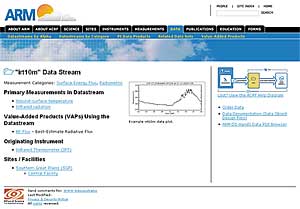One More Step for Improving User Access; A Giant Leap Toward Integration
Published: 15 February 2005

In early February, the arm.gov website took one more step towards the goal of helping users access data. The ARM Climate Research Facility website staff published a significant reorganization to a major portion of the website—specifically, the instrument and data web areas—and also added a measurements area. The reorganization will assist new users in learning about the various data products available at the Data Archive. This step provides users with “smarter” navigation to lead them from a site, instrument, measurement, or data entry point to the associated data stream.
As part of this effort, the instrument pages were restructured to de-emphasize the discussion of the instrument, instead placing more emphasis on accessing and using the data. The instrument details are still accessible, but are now included in an easy-to-download PDF file called an “Instrument Handbook.” In addition, for each primary measurement taken at the ARM Climate Research Facility sites, new web pages were created to link these measurements to their associated instruments and data streams. Because these related pieces of information are used repeatedly throughout the website, a database was created to manage this content more easily. This database was designed with the goal of linking it to the underlying tables at the Archive for data ordering purposes.
As the next step in further integrating arm.gov with the Archive, the ARM Climate Research Facility web development staff met on February 9 and 10 to outline steps needed to complete the ability to order data from arm.gov. The following actions resulted from the meeting, and will be tackled throughout the coming months: build a “shopping cart” functionality to order data from arm.gov; extend the existing Archive database tables on the arm.gov server; and update existing web pages to accept the shopping cart functionality and identify duplicate content that should be standardized.
The ARM Climate Research Facility is a DOE Office of Science user facility. The ARM Facility is operated by nine DOE national laboratories, including .
Keep up with the Atmospheric Observer
Updates on ARM news, events, and opportunities delivered to your inbox
ARM User Profile
ARM welcomes users from all institutions and nations. A free ARM user account is needed to access ARM data.


















